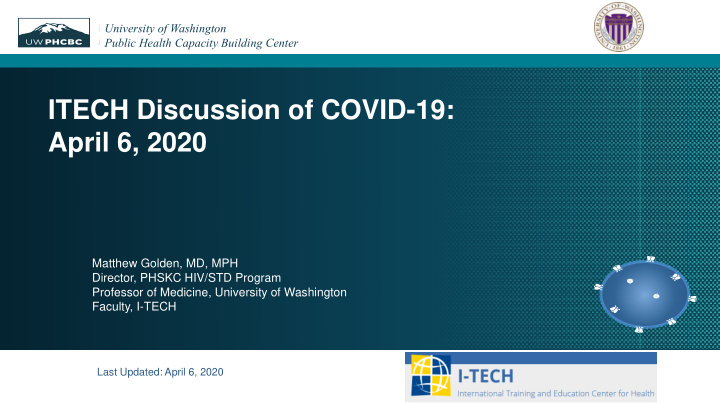



University of Washington Public Health Capacity Building Center ITECH Discussion of COVID-19: April 6, 2020 Matthew Golden, MD, MPH Director, PHSKC HIV/STD Program Professor of Medicine, University of Washington Faculty, I-TECH Last Updated: April 6, 2020
Agenda • Evolving evidence related to asymptomatic infections • Review changing guidelines on PPE use
WHO Guidelines • Updated March 27, 2019 – No significant changes • Sick patients to prevent contamination of the surrounding area when they cough or sneeze. • Healthcare workers - During discrete episodes of direct patient care that may result in close contact to patients with respiratory symptoms - doff after each interaction. • Not outside of direct patient care or housekeeping. • Conserve PPE
PPE: Who Needs PPE? PPE Recommended* Clinical care & visitors symptomatic persons Yes Cleaners rooms of patients with Covid-19 Yes Triage of patients for symptoms as they enter No healthcare facility Care of asymptomatic patients No Driving in a car with other healthcare workers No Administrative staff in healthcare facilities No PPE includes masks, gloves, gown and eye shield For more detailed description see WHO guidance: Rationale use of PPE for Covid19 – on intranet site
Increasing Evidence that Covid-19 Can be Transmitted by Persons who are Symptomatic • Viremia present 1-2 days prior to onset of symptoms (Anderson R. Lancet 2020) • Cruise ship outbreak – 634 cases – 52% asymptomatic when tested – ~17.9% never developed symptoms (Mizumoto K. Euro Surv. 2020) • Nursing home outbreak King County – 13 (57%) of 23 cases asymptomatic – 7/10 asymptomatics developed symptoms in the next 7 days Quantity of viral shedding not clearly associated with presence of symptoms (Kimball MMWR 2020)
Increasing Evidence that Covid-19 Can be Transmitted by Persons who are Symptomatic • Analysis of subset of cases with well-defined exposure (3d period) while visiting Wuhan or time limited contact to a case • 50 1 st generation cases and 74 second generation cases • Back calculate onset of infectiousness based on estimated incubation period • Estimated 73% cases transmitted by infected people before symptom onset Symptom onset first generation cases Infection secondary cases Symptom onset secondary cases Xia, et al. medRxiv 2020.03.06.20031955.
Pre-Symptomatic Transmission May be Common Key Idea – If the time Seasonal flu between symptom onset in linked cases is shorter than the incubation period (time SARS 2003 infection to symptoms), then some of the transmission has to occur Covid-19 prior to the transmitting case’s onset of symptoms He, et al. medRxiv 2020.03.15.20036707.
Coronavirus May be in Aerosols (Not Just Droplets) but is Blocked by Surgical Masks • Patients with symptoms of acute respiratory virus infections enrolled • Breath into a bioaerosol collecting device – distinguishes >5µm (droplet) from <5µm (aerosol) particles • Bad news: Seasonal coronavirus detectable in aerosols • Good news: Surgical masks decrease detection • Is Covid-19 the same? Leung N. Nature Medicine 2020
Implications of Asymptomatic Shedding & Transmission • Transmission before onset of symptoms appears to be common in at least some instances • Studies evaluating the percentage of cases transmitted prior to development of symptoms may not be generalizable • Seems likely that some significant number of infections are transmitted by people who are asymptomatic • Isolating symptomatic persons will not avert all transmission • Suggests need for broader-based interventions • We were already doing that – social distancing • Some of the change in PPE policy is driven by science, and some of it is being driven by other things – need to be responsive to the population’s desire to do something
New Policies in the US • 3/27/20 – WHO – No change in recommendations • 3/29/20 - UCSF – All staff and visitors should wear a medical mask while in the hospital • 4/1/20 - UW – Optional use of medical mask by all staff – 1 mask per shift • 4/3/20 - CDC • CDC recommends wearing cloth face coverings in public settings where other social distancing measures are difficult to maintain (e.g., grocery stores and pharmacies) especially in areas of significant community-based transmission.
Implications of Evolving Standards • Anticipate continued increase in demand for PPE and staff concerns • Need to conserve and expand supply of PPE • Procure PPE as possible • Reuse of sterilized N95s • Develop cloth PPE as a last resort (if legal) • New ITECH general guidance document on intranet
DISCUSSION
Recommend
More recommend